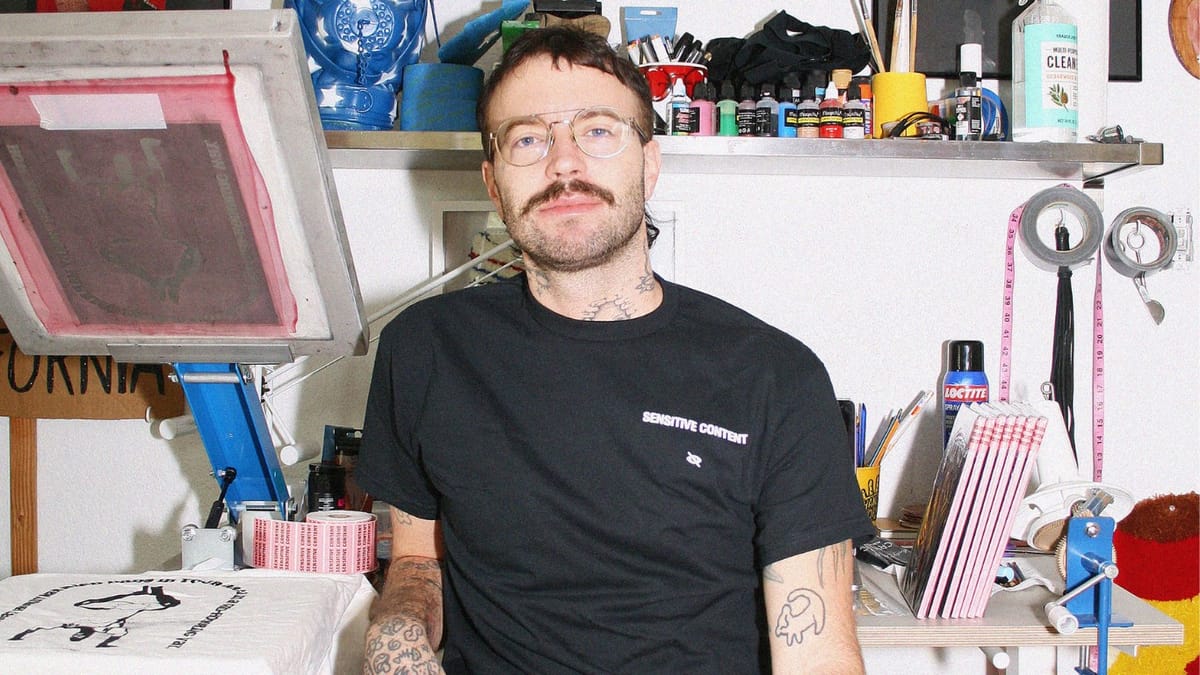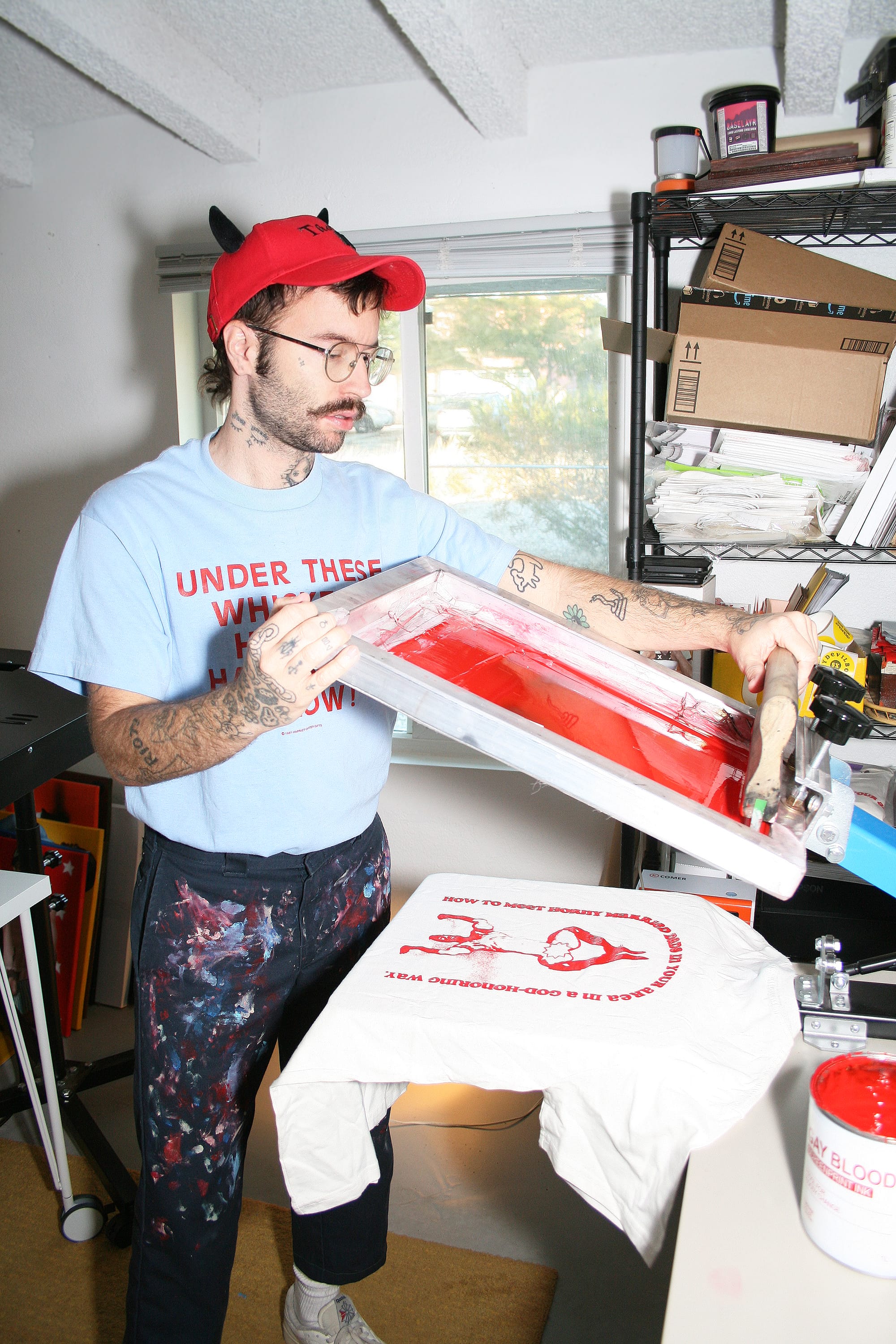Artist, founder boosts censored queer creators in print magazine
Zain Curtis's print magazine, SENSITIVE CONTENT, is a “visual showcase of artwork and photos by LGBTQIA+ creators that have been removed or restricted by social media platforms.”

- In a content removal study conducted by Salty and the University of Michigan, 61.9% of people surveyed experienced content removals from Instagram.
- Queer and marginalized people are more likely to be censored from Instagram according to a report.
- Global paper use has increased by 400%; every year sees over 24 billion newspapers, 350 million magazines, and 2 billion books published in the US alone.
If you’re a queer person who fancies erotic art, raunchy porn, drag culture, and controversy, then you’ve gotten your gooey thumb stuck onto a kink-inspired photo of creator Zain Curtis.
Curtis, also known by his Instagram handle @Happydevilboy or his magazine, SENSITIVE CONTENT @sensitivecontentmag, has built an extensive career in queer media — and he loves creating media around all things sex, specifically kink and fetish.
“I always found it so mind-blowing that we have the most fucked up relationship with what is the most natural to us — blood, urine, cum, menstruation, sex, shitting, vomit — like if everything else in the world disappeared and it was just our bodies, these would be all we know,” said the SENSITIVE CONTENT magazine founder.

When Curtis began creating art on these topics in a social media-focused world, he was met with a lot of post removal, shadow bans, and full-on account bans. He also started noticing a trend: queer creatives were constantly getting scrubbed and censored from the Internet.
“Most things I created were things purely to be viewed on social media,” the sex industry entrepreneur said. “I didn’t keep copies of it, so all of my photos of that time in my life, the things I made, and everything about it were just gone forever,” he said. “People are like, ‘Oh, what you post on the internet lasts forever,’ but that’s so not true.”
He adds that Meta, the parent brand of Instagram has bulldozed any competing apps that would be a suitable outlet for his art and that banks and, payment processors have the overall decision on what rules apps must follow if they want to work with mainstream consumers.
In a content removal study conducted by Salty and the University of Michigan, 61.9% of people surveyed experienced content removals from Instagram. “The majority of participants who experienced content removals appealed Instagramʼs content removal decisions (52.9%), but most of them either received no response or their content was not reinstated. Only six participants (8.2% of those who appealed their content removal) had their content reinstated by Instagram.”
SENSITIVE CONTENT was born out of a reaction to the censoring of queer artists. Curtis describes the magazine as a “visual showcase of artwork and photos by LGBTQIA+ creators that have been removed or restricted by social media platforms.”
“It came together naturally, and before I knew it, I found so many cool artists going through the same issues with social media,” he said. “It’s [SENSITIVE CONTENT] a baby to me. I’m still figuring out what the future of it can be, but right now, it’s been a fun side project when I’m not working on my own things.”
At first, the Happy Devil Boy painter said the magazine was purely about removed posts, but he realized a huge rift in queer people online between their own ideas of what SENSITIVE CONTENT was supposed to be about.
Curtis wants the magazine to be an unbiased and offline space for any and all ideas by queer and trans people, not a bubble of similar thinking.
“It’s hard to figure that out and make that a sellable thing to different types of people because no one really wants to listen to anyone that they don’t fully agree with anymore,” he said. “There’s a formula to it that I haven’t harnessed yet, but I’m excited for its growth.”
In his magazine, Curtis and his creatives cover topics of all sorts: gooning, trans bodies, public sex, political activism and more. With the tagline, “Make the Algorithm Cum,” the featured uncensored creators certainly don’t edge their audience for long.
Because the topics in SENSITIVE CONTENT are graphic, Curtis said he had a hard time finding a printer. He currently uses a general online printer to produce the magazine but wants to find a smaller, local company that is more hands-on with the way it’s made with more customizable options.
“I contacted so many of them and got rejected,” he said. “When they heard what the magazine’s theme is, and usually, a reply was something like, ‘This doesn’t align with our company’s values.’”
As if finding a printer is difficult enough, Curtis also has to factor in the cost of paper when producing his magazine. In the last 40 years, global paper use has increased by 400%. Last year saw over 24 billion newspapers, 350 million magazines, and 2 billion books published in the US alone. Then, factor in simple supply and demand concepts. In 2020, the COVID-19 pandemic brought the price of paper down to 2.6 percent because people weren’t using it as much, but when the economy reopened in 2021 alongside supply chain disruptions, the price of paper increased 9.7 percent.
The Bottom line, paper is expensive right now and Curtis is feeling that burden, with his most recent magazine costing around $10,000 to produce and print.
“Of course, a lot of it is the printing cost,” he said. “It’s such a gamble every time doing a print project because it only gets more expensive, and I have to guess how many to make and if it would sell well enough to return that money and go towards the next issue.”
But is it worth it? He says yes, even though his credit cards take some abuse…maybe it’s some findom kink for him? He believes that people love collecting things like tangible magazines — something the internet hasn’t taken away from the world quite yet.
“It is a different feeling to hold content you enjoy in your hands versus seeing it on a screen,” he said. “There’s much more attachment to it, and I think it lingers in people’s minds more.”
Although Curtis may be known well for his provocative nudey magazine during this portion of his 15 minutes of fame, the well-rounded artist has been in the game since an early age.
After leaving his hometown of Bowling Green, Ky., he landed where many midwestern/southern gays land: Chicago. The Windy City is where Curtis went to film school, began DJing and curating events, and started his first publication, Teen Witch Magazine.
“[It] was what I called an underground teen magazine that featured all trans and queer artists and social media personalities of the time. It was basically promoting my friends, but I made it look like a teeny-bopper magazine and made fold-out posters, sticker sheets, and puzzles for them,” he said. “It was like a way of finding cool people and instantly idolizing them. I think SENSITIVE CONTENT is like the adult version of that.”
One of Curtis’ projects went viral in 2022 when he used gay men’s blood to screenprint T-shirts in protest of the blood ban on queer men. In a statement on his Instagram Curtis said, “No, really. Printed with ink infused with the blood of gay men. Using screen printing ink from Stuart Semple × Mother's GAY BLOOD collection.”

Bold and controversial pieces are at the core of Curtis’ entrepreneurial journey — so is his personality. He said his favorite aspect of being a founder is the independence. And who could blame him?
“If I want to fuck off I can and most likely will, probably to a fault,” he said. “I can create my own world and make something from nothing. That’s got to be a skill within itself.”





